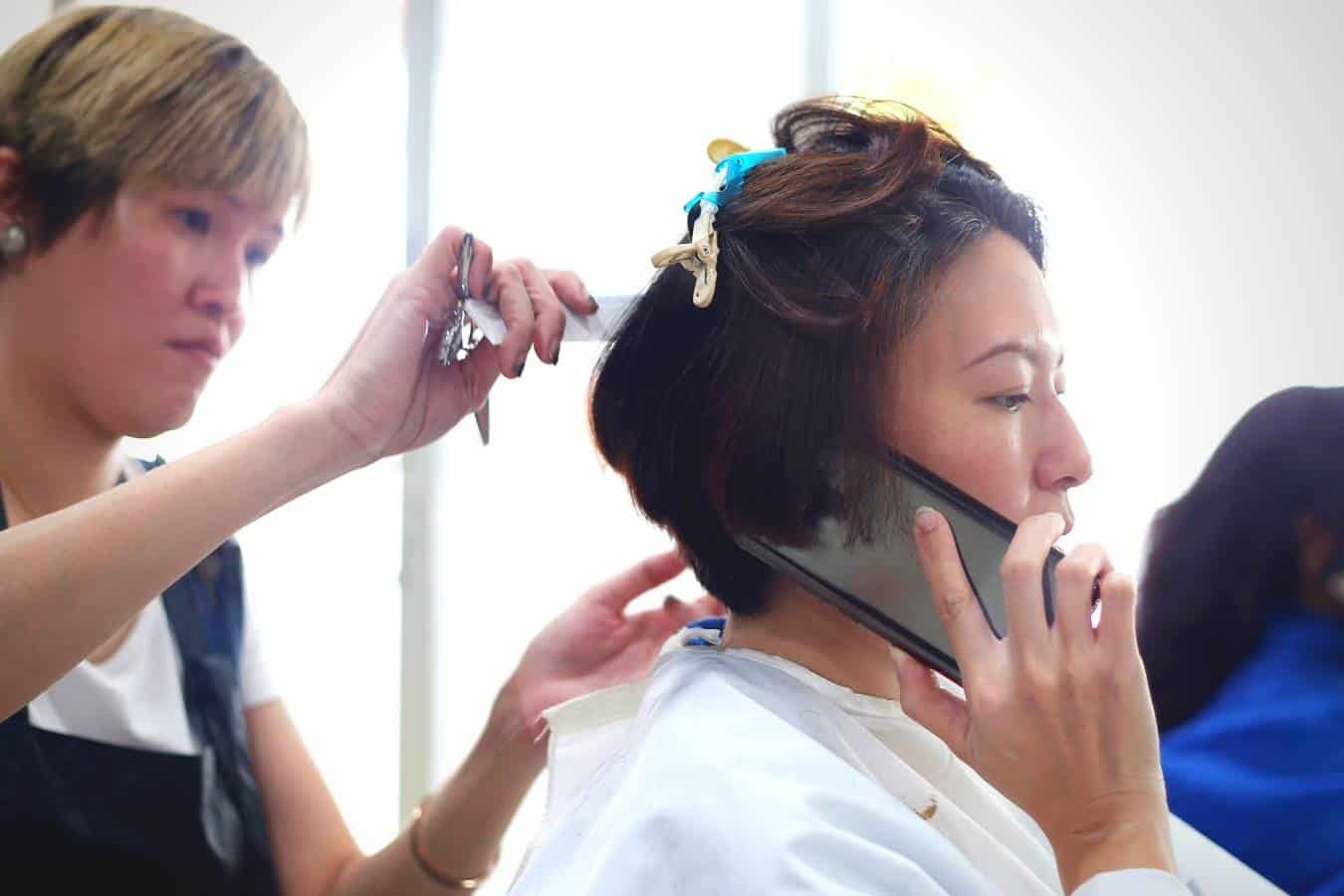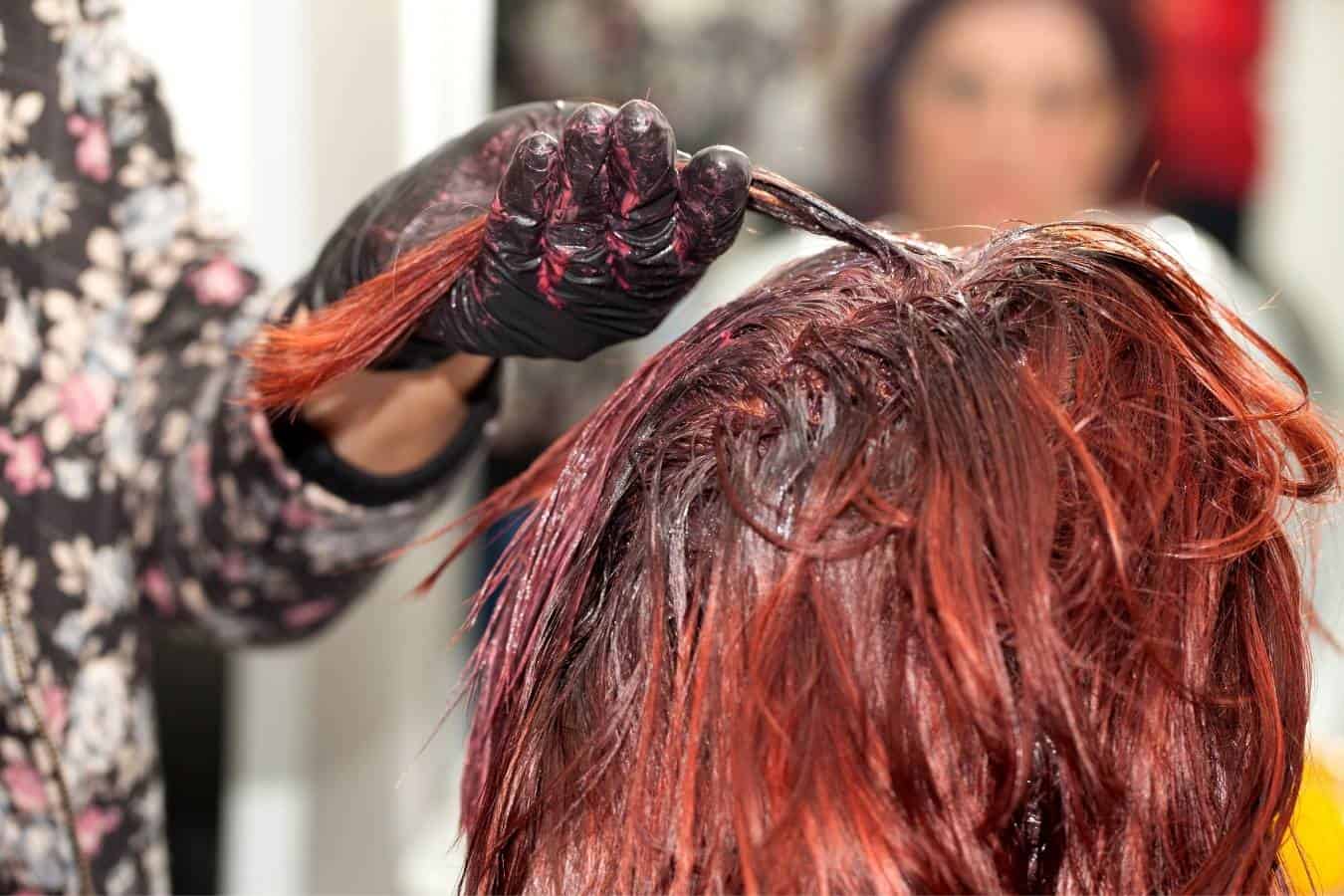Ammonia in hair dye is a hot topic of debate. Some people say it’s safe to use, while others are convinced that ammonia in hair dye is dangerous for your health.
But is it truly safe to use it in hair dye?

Ammonia is primarily safe for use in hair dye, but this also depends on how you use it. It can cause dryness and damage your scalp if you don’t rinse it properly afterward. But when you use it correctly, ammonia helps open up your hair cuticles, so the dye penetrates deeper into the cortex.
Why Do Hair Dyes Contain Ammonia?
Ammonia is used in hair dye to help the hair color stick better.
It’s also an effective stripping agent, which means it can remove any dirt and oil from your hair before you apply a new color.
Ammonia also helps to increase the pH level of the hair.
This makes it easier for ammonia to work its way through your existing color.
It removes unwanted pigments and opens up each strand of hair so that you can apply new colors on top.
What’s more, ammonia helps with penetration, assisting chemicals in moving from the outside of your hair to the inside, where they will do some good coloration job.
In simple terms, ammonia is the swelling agent that bests the absorption rate of the hair cuticle.
You can expect an ammonia-based hair dye to last longer in your hair than a non-ammonia-based one.
Also Read: Does Hair Dye Expire? (Everything You Need To Know)
Is Ammonia Safe To Use?
While ammonia is the most effective compound for dyeing your hair, it also has a few setbacks.
For instance, you should never use ammonia on color-treated hair.
It will strip away even your lightest tones of blonde, leaving you with a weird brassy mess that you’ll have to fix immediately through another bleaching session (or a visit to the salon).
So if you’re still wondering if ammonia is safe to use, the short answer is, yes, it is.
It’s been used as a hair dye agent since the 20th century and is primarily regarded as one of the least damaging components in any coloring recipe.
Additionally, ammonia is generally safe to use in the right amounts.
But it’s best to go into bleaching or coloring knowing that once you’ve used ammonia on dyed hair, there’s no going back until those strands grow out and the damage is cut off.
So, there isn’t much to worry about when using ammonia-based hair dyes unless you are allergic or are known to suffer side effects from stronger chemicals.
Potential Side Effects of Ammonia

Ammonia is a pH adjuster and reacts with water to form ammonium hydroxide, which means ammonia will have varying effects on different hair types.
This can provide ammonia with some side effects like:
Skin Irritant
Ammonia can cause irritation and itchiness on the scalp, which is why it’s always recommended to wear gloves when applying hair dye.
Once ammonia mixes with water to form ammonium hydroxide, you’re likely to experience some irritation on your skin once this mixture gets into your scalp or any bare skin.
Allergic Reaction
Ammonia-based dyes may contain other chemicals that could potentially trigger allergies.
The ammonia itself is not likely to cause an allergic reaction, but other additives in hair dye might do so.
Damage to the Cuticle
Repeated use of ammonia-based hair dye can damage the cuticle or top layer of your hair.
This is because ammonia opens up the cuticles to make it easier for dye molecules to bind with them and penetrate your hair strands.
With the cuticles continuously open, a lot of moisture escapes, leaving dry, brittle, and curly hair.
Penetration into the Bloodstream
Those who are continuously exposed to ammonia-based hair dyes may end up having ammonia strains in their blood systems.
Ammonia can penetrate the scalp and enter the bloodstream to cause problems with the respiratory system.
Inhalation of ammonia fumes from hair dye can lead to asthma and other breathing-related problems.
This is especially true when ammonia is mixed with other chemicals in a formula.
In some cases, even small amounts of ammonia vapors present in hair dyes can cause breathing difficulties for everyone within a room.
Ammonia Can Harm The Ecosystem
Ammonia can alter the environment of a water body in ways that are toxic, harmful, and even deadly to plants, animals, and fish.
Environmental scientists warn ammonia-based hair dye products may be releasing ammonia pollution into the waterways when users pour unused or leftover products down sinks or toilets.
When wastewater treatment plants fail to remove ammonia, the amount in hair dye products may find its way into waterways and eventually harm plants and animals.
Also Read: How To Get Hair Dye Off Skin (8 Methods That Work!)
Does Every Hair Dye Contain Ammonia?
In the early days of hair dye manufacturing, ammonia was used in most hair dye products. It was almost impossible to get ammonia-free hair dye in the market.
However, ammonia-free and ammonia-reduced dyes are now available for shoppers to choose from.
So when you’re shopping, you can decide on which one to choose.
Ammonia-Free vs. Ammonia-Based Hair Dyes: What’s the Difference?
Like the names suggest, ammonia-free hair dyes don’t contain ammonia in any form.
Ammonia-based products, on the other hand, are created with ammonia to help them absorb and retain the dye in your hair strands for a longer time.
However, the difference between these two types of hair dye products doesn’t end with ammonia.
The other differences are:
Ammonia-Based Products Tend to Last Longer on the Hair
Ammonia is a base, while ammonia-free hair dye products are acidic because of their natural ingredients.
If you’re dyeing your hair with ammonia, the ammonia in hair dye works to “lift” and remove any natural oils from your scalp.
This is why ammonia-based products tend to last longer as they bond to hair better than ammonia-free products.
Ammonia-Based Products Increase Your Risk of Allergic Reactions
Some ammonia in hair dye products also contains other ingredients like resorcinol, which can cause allergic reactions.
If you’re already at high risk of having an allergic reaction (i.e., if you have susceptible skin), it’s best to avoid ammonia-based hair dye altogether.
This is because using ammonia increases your risk of having an allergic reaction.
Even if ammonia in hair dye causes no allergic reactions for you, it can still irritate your scalp and damage your hair’s health over time.
Ammonia-Free Products Dyes Produce Less Optimal Results
Just because ammonia is bad for your hair and scalp doesn’t mean all ammonia-free products dyes are the best choice.
Most of these ammonia-free dye alternatives don’t produce rich color results as ammonia does.
They also often take longer to process on the hair than an ammonia product would.
The main reason behind their slow reaction in your hair is that they use agents with much larger molecules.
These large molecules don’t easily penetrate the hair follicles to give the optimal results you’re looking to achieve.
What’s more, many ammonia-free products dyes contain either resorcinol or hydrogen peroxide, which can cause another set of problems.
Ammonia-Free Hair Dyes are Less Smelly than Ammonia-Based Dyes
The ammonia in hair dye contributes to the smell you experience while coloring your hair.
It’s ammonia reacting with hydrogen peroxide that creates this strong and often unpleasant odor.
Ammonia-free dyes avoid this reaction altogether, producing a less noticeable smell.
The products don’t contain ammonia or any other harsh-smelling chemicals.
Benefits of Using Ammonia-Free Hair Dye

Ammonia-free hair dye is slowly becoming a preferred choice for many hairstylists and their customers.
The reason for this is the many benefits associated with ammonia-free hair dyes.
Some of these benefits are:
A Natural Looking Finish
Achieving a natural-looking finish is one of the biggest benefits of ammonia-free hair dye.
Ammonia-based hair dye is used in traditional, high ammonia content dyes to open up the cuticle and allow for deeper penetration of chemicals into your strands.
This often means that less natural-looking results are achieved due to the damage done by these harsh chemicals.
The case is, however, different with ammonia-free hair dyes.
These ammonia-free alternatives don’t open up the cuticle, which allows for a more natural look to be achieved after rinsing your hair and styling it.
Protects and Leaves your hair Shiny
While ammonia-free hair dye may not open up the cuticle, it certainly does an excellent job of closing down the pores in your strands that have been opened due to chemical damage.
This allows you to achieve a beautiful and healthy look after rinsing out your ammonia-free hair dye because all the rough edges are smoothed over.
They are Safer to use than Ammonia-Based Hair Dye.
Ammonia-free hair dyes use monoethanolamine (MEA) as a base instead of ammonia.
While ammonia is undoubtedly an irritant, MEA has been declared safe by the FDA for use as a cosmetic ingredient.
It works to open up the cuticle so that your dye can easily enter your hair.
Ammonia-based dyes have also been known to produce fumes that are harmful if inhaled. However, that’s never the case with ammonia-free dyes.
Disclaimer: This site is not intended to provide professional or medical advice. All of the content on LovedByCurls.com is for informational purposes only. All advice should be followed at your own discretion. Ingredients may change at any time so always check the product label before using. Check our full disclaimer policy here.
